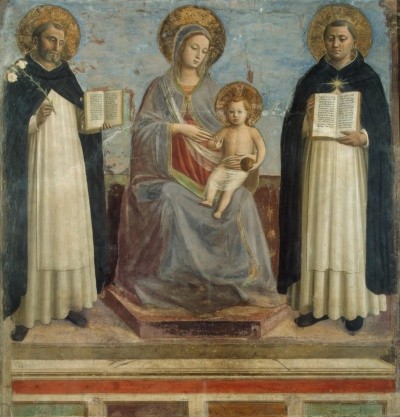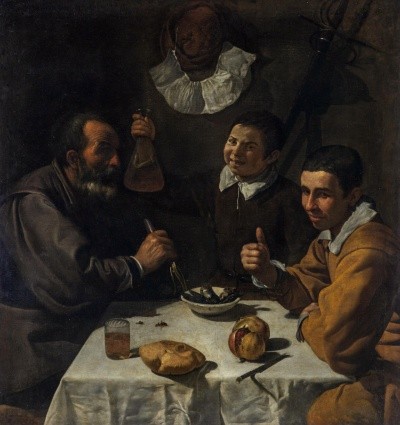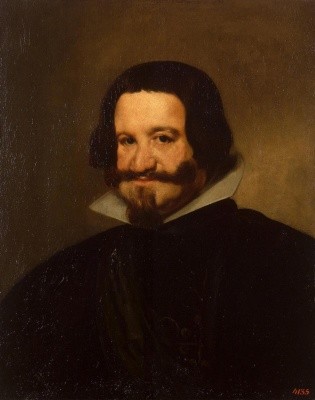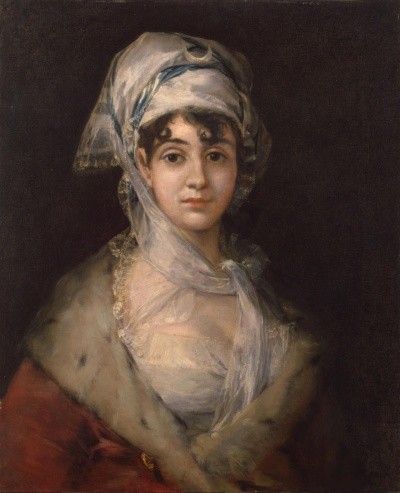Vision of St. Augustine by Filippo Lippi.

“Vision of St. Augustine'' by Filippo Lippi circa 1460. Aurelius Augustinus was a bishop of Hippo Regiusin Northern Africa (Nowadays Algeria) and one of the Fathers of the Church. Originally part of an altar, this work takes its subject from a description of the life of St. Augustine. The legend says that the monk Augustine, pondering on the dogma of the Holy Trinity, went to the seaside. Augustine was trying to comprehend the dogma of the divine Trinity as he walked along the seashore when he saw a small boy removing water from the sea with a spoon and pouring it into a hole. When Augustine asked him the purpose of what he was doing, the child answered that any attempt by the human mind to comprehend the mystery of the nature of God...
The Virgin and Child with Saints Dominic and Thomas Aquinas by Fra Beato Angelico.

No European country is as famous for its magnificent monumental frescoes - paintings on walls applied directly to wet plaster - as Italy in the period of the Renaissance. However, museums outside Italy contain few examples of frescoes. This exception is “Virgin and child with Sts Dominic and Thomas Aquinas” by Fra Beato Angelico. It is a fresco from the Monastery of Saint Dominique in Italian town Fiesole, where Fra Angelico, a Dominican monk, was prior. After the monastery was closed in the 19th century this fresco was removed and sold to the Florentine painters A. Mazzonti and C. Conti, who then sold it to the Hermitage. This symmetrical composition, with the Madonna enthroned and surrounded by saints, developed in the medieval period...
Madonna from the Annunciation Scene by Simone Martini

Madonna from the Annunciation Scene by Simone Martini. Virgin Mary is depicted against the golden background, her head brewed, she listening calmly to the words of Archangel Gabriel who brought her the evangel telling her that she is to give birth to the Saviour of the human race. Seated on a cushion, Simone's Madonna is the very embodiment of elegant femininity. Here the artist sought to embody not the physical but the spiritual in the appearance of Mary. Her figure seems to have no corporeal volume and rather looks like a silhouette against the warm reddish gold ground. This painting was once the right-hand wing of a folding diptych showing the Annunciation. The left wing, with its image of the Archangel Gabriel, is now in the...
Luncheon by Diego Velázquez

Luncheon or “Breakfast” (about 1617). It comes from a famous series by Velázquez called “Bodegones” – scenes of everyday life. In the painting here we can see the genre scene of a regular meal, where three common Spanish persons of different ages eat in the tavern. It’s a combination of a group portrait and still life. We see ceramic dish with fish, a glass of wine, pomegranate and bread. A boy in the center of the painting looks excited and smiles – for the first time in his life he is allowed to sip some wine with the adults. The young man looking at the audience in the right part of the painting is supposedly Velázquez self – portrait.
Portrait of Gaspar de Guzman, Count-Duke Olivares by Diego Velázquez

Unlike most of his contemporaries Diego Velázquez painted very few pictures on religious subjects, concentrating mainly on the portrait. He produced some excellent portraits of Philip IV of Spain. The king was an admirer of his work and even had a key to Velázquez studio and his special chair where he would sit watching the artist at work. Velázquez also frequently painted Count Olivares – king’s favorite and a clever but cruel statesman who took advantage of Philip’s week will. This portrait is an outstanding example of the psychological portraiture in Catholic Europe in those days. The person we see in the portrait is a significant political figure in Spain of the XVII century. Philip IV of Spain (1605 – 1665) ascended Spanish throne...
Portrait of the Actress Antonia Zarate by Francisco Goya

Antonia Zarate was an actress, member of psychological theatre which was very popular in Spain then. She was famous and loved. Antonia and Francisco were true friends and she was always there for him during his “times of troubles”. Here Antonia is depicted being very sick. She had tuberculosis which was not curable in those days. They both knew she was going, so it is very personal and very sad work by Goya. It was his last farewell to his beloved friend Antonia. She died soon after the portrait was finished.
The Virgin and Child by Luis de Morales

Luis de Morales was a Spanish painter active during the Spanish Renaissance in the XVI century. Known as "El Divino", most of his work was of religious subjects, including many representations of the Madonna and Child and the Passion.
Apostles Peter and Paul by El Greco.

El Greco depicted two Apostles as two completely different personalities, which was quite an innovation in art in those days since in religious perspective they belonged to other worldliness. The person in the left part of the painting is a simple fisherman Peter from Galilee with all the weaknesses of human nature. Peter was arrested, he got scared and denied Christ, but later accepted his guilt, repented and received forgiveness – Christ gave him the keys from Paradise. His head in the painting is bowed, his gaze is sad and thoughtful and his pale aged face is framed with greying hair – all this emphasizes his humble, good, gentle and indecisive character. The person in the right part of the canvas is the scientist from a noble family...